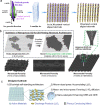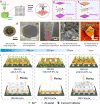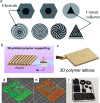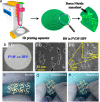The status and challenging perspectives of 3D-printed micro-batteries
- PMID: 38638219
- PMCID: PMC11023027
- DOI: 10.1039/d3sc06999k
The status and challenging perspectives of 3D-printed micro-batteries
Abstract
In the era of the Internet of Things and wearable electronics, 3D-printed micro-batteries with miniaturization, aesthetic diversity and high aspect ratio, have emerged as a recent innovation that solves the problems of limited design diversity, poor flexibility and low mass loading of materials associated with traditional power sources restricted by the slurry-casting method. Thus, a comprehensive understanding of the rational design of 3D-printed materials, inks, methods, configurations and systems is critical to optimize the electrochemical performance of customizable 3D-printed micro-batteries. In this review, we offer a key overview and systematic discussion on 3D-printed micro-batteries, emphasizing the close relationship between printable materials and printing technology, as well as the reasonable design of inks. Initially, we compare the distinct characteristics of various printing technologies, and subsequently emphatically expound the printable components of micro-batteries and general approaches to prepare printable inks. After that, we focus on the outstanding role played by 3D printing design in the device architecture, battery configuration, performance improvement, and system integration. Finally, the future challenges and perspectives concerning high-performance 3D-printed micro-batteries are adequately highlighted and discussed. This comprehensive discussion aims at providing a blueprint for the design and construction of next-generation 3D-printed micro-batteries.
This journal is © The Royal Society of Chemistry.
Conflict of interest statement
There are no conflicts to declare.
Figures























References
-
- Bandari V. K. Nan Y. Karnaushenko D. Hong Y. Sun B. Striggow F. Karnaushenko D. D. Becker C. Faghih M. Medina-Sánchez M. Zhu F. Schmidt O. G. Nat. Electron. 2020;3:172–180. doi: 10.1038/s41928-020-0384-1. - DOI
-
- Dieny B. Prejbeanu I. L. Garello K. Gambardella P. Freitas P. Lehndorff R. Raberg W. Ebels U. Demokritov S. O. Akerman J. Deac A. Pirro P. Adelmann C. Anane A. Chumak A. V. Hirohata A. Mangin S. Valenzuela S. O. Onbaşlı M. C. d'Aquino M. Prenat G. Finocchio G. Lopez-Diaz L. Chantrell R. Chubykalo-Fesenko O. Bortolotti P. Nat. Electron. 2020;3:446–459. doi: 10.1038/s41928-020-0461-5. - DOI
-
- Beidaghi M. Gogotsi Y. Energy Environ. Sci. 2014;7:867. doi: 10.1039/C3EE43526A. - DOI
Publication types
LinkOut - more resources
Full Text Sources

